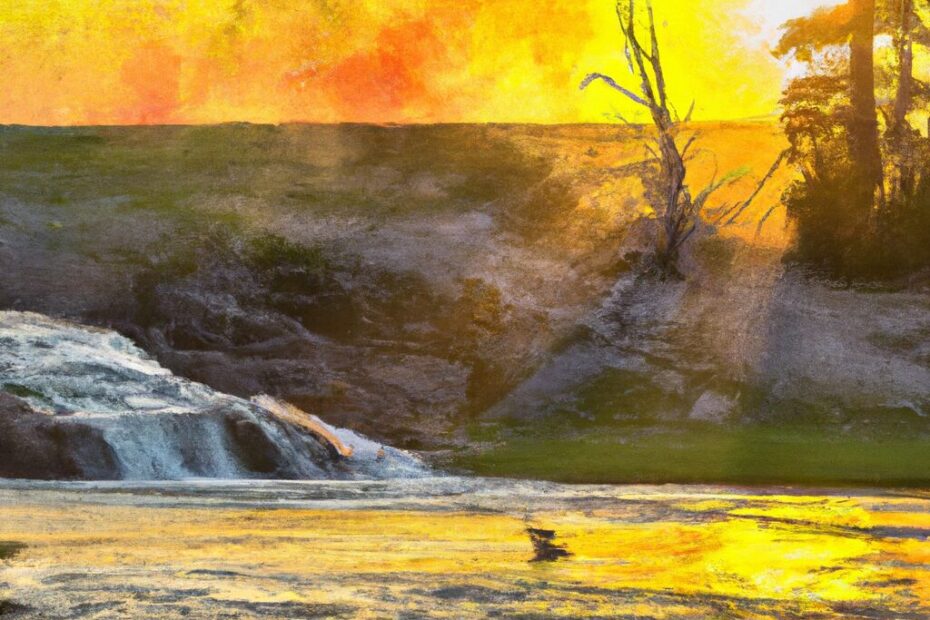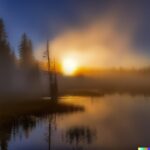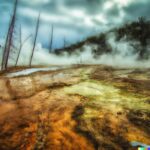Yellowstone National Park is home to some of the most famous geysers in the world, each with its own unique features and characteristics.
From the iconic Old Faithful to the awe-inspiring Steamboat Geyser, these natural wonders draw visitors from around the globe.
In this article, we’ll explore what makes Yellowstone National Park special, the unique features of its geysers, and how you can visit these incredible natural attractions.
So, let’s dive in and discover the fascinating world of geysers!
What Are Geysers?
Geysers are unique hydrothermal features found in Yellowstone National Park, characterized by spectacular eruptions of boiling water and steam caused by geothermal activity.
Geysers are formed by a combination of geological processes and underground hydrothermal activity. Water seeps deep into the Earth’s crust and is heated by magma, then stored in underground chambers. As the superheated water rises, it encounters a constriction in the geyser’s plumbing system, building up pressure until it erupts in a towering column of boiling water and steam. These unique features make geysers a captivating subject for geologists and a breathtaking sight for visitors.
Where Is Yellowstone National Park?
Yellowstone National Park is located primarily in the state of Wyoming, United States, and is renowned for its breathtaking natural wonders. These include unique geological formations, volcanic landscapes, and unspoiled wilderness.
Spanning over three states, including Idaho and Montana, Yellowstone National Park covers an area of 3,472 square miles. It is one of the largest national parks in the U.S. and is home to mesmerizing features such as the iconic Old Faithful geyser.
The park also boasts colorful hot springs, bubbling mud pots, and the stunning Grand Canyon of the Yellowstone. Its diverse ecosystem supports a variety of wildlife, including grizzly bears, wolves, and herds of bison and elk, making it a truly unforgettable experience for visitors.
What Makes Yellowstone National Park Special?
Yellowstone National Park holds a special place as a premier tourist attraction, offering an abundance of natural wonders, diverse wildlife, and a strong commitment to environmental conservation.
Yellowstone National Park is a haven for nature and wildlife enthusiasts, with its iconic geothermal features and renowned Old Faithful geyser drawing visitors from all over. From colorful hot springs to dense forests and alpine meadows, the park’s vast expanse encompasses diverse ecosystems. It serves as a refuge for a variety of animal species, including bison, wolves, and elk.
The park’s commitment to conservation and sustainability is evident, showcasing a dedication to preserving this unique natural paradise for future generations to cherish and explore. With its breathtaking landscapes and abundant wildlife, Yellowstone is a must-visit destination for anyone seeking a true connection with nature.
How Many Geysers Are In Yellowstone National Park?
Yellowstone National Park is home to an impressive number of geysers, making it a prominent destination for those seeking the marvels of thermal features and natural landmarks.
The park boasts over 500 geysers, more than half of all the geysers found on Earth, captivating visitors with their spectacular eruptions and steaming pools. These geothermal wonders, such as Old Faithful, Grand Geyser, and Steamboat Geyser, showcase the raw power of the Earth’s thermal energy.
Their unique formations and colorful mineral deposits add to the enchanting allure of the park’s diverse landscape. Visitors to Yellowstone can witness the ongoing geothermal activity, granting insight into the Earth’s geological processes and the beauty of natural phenomena.
What Are The Famous Geysers In Yellowstone National Park?
Yellowstone National Park is renowned for its famous geysers, with notable names such as Old Faithful, Steamboat, Excelsior, Grand, Castle, Riverside, Beehive, and Fountain among its celebrated thermal features.
These geysers offer unique experiences due to their individual characteristics.
For instance, Old Faithful, erupting at regular intervals, is one of the most predictable geysers in the world and has been a popular attraction since Yellowstone’s early days.
Steamboat Geyser, known for its rare and powerful eruptions, holds the title of the world’s tallest active geyser.
The historical significance of these iconic geysers in shaping the park’s identity and attracting millions of visitors annually cannot be overstated.
Old Faithful
Old Faithful, an iconic geyser in Yellowstone National Park, is known for its predictable and impressive eruptions, showcasing the mesmerizing display of geological and hydrothermal activity, a compelling natural phenomenon.
Old Faithful, one of the most famous geysers in the world, is known for its regular and consistent eruptions, lasting between 1.5 to 5 minutes and occurring approximately every 90 minutes. Reaching impressive heights of around 100-180 feet, this geyser has earned its name by captivating visitors with its reliability.
Aside from its impressive displays, Old Faithful also holds significant geological significance. It is connected to the Yellowstone supervolcano, showcasing the underlying forces that shape the dramatic terrain of the park. As a testament to the remarkable power and beauty of nature’s geothermal phenomena, Old Faithful continues to awe and inspire visitors from all over the world.
Steamboat Geyser
Steamboat Geyser, the world’s tallest geyser, captivates visitors with its unpredictable yet spectacular eruptions. Located in Yellowstone National Park, this breathtaking natural phenomenon can reach heights of up to 300 feet, making it the tallest geyser in the world. These eruptions can last anywhere from 3 to 40 minutes, leaving spectators in awe.
The geyser is set against the stunning backdrop of Yellowstone’s picturesque landscape, enhancing the overall experience for onlookers. With its impressive eruptions and beautiful surroundings, Steamboat Geyser truly is a remarkable sight to behold.
Grand Geyser
Grand Geyser, known for its majestic eruptions, holds historical significance as one of the iconic thermal features in Yellowstone National Park, captivating visitors with its compelling display.
Grand Geyser has a rich history dating back to the early explorations of the park, and its unique eruption characteristics draw in visitors from all over. With eruptions reaching heights of up to 200 feet, it is one of the tallest geysers in the world. Its intermittent and unpredictable eruptions only add to the excitement, as spectators eagerly await the powerful bursts of boiling water and steam. For decades, these eruptions have put on a breathtaking natural spectacle that continues to captivate adventurers and nature enthusiasts.
Castle Geyser
Castle Geyser’s eruptions, set against the backdrop of captivating surrounding scenery and unique geological formations, create a mesmerizing display, adding to the allure of Yellowstone National Park.
The geyser’s eruptions can reach heights of up to 90 feet, casting a spectacular sight against the clear blue sky. The surrounding landscape, adorned with lush greenery and vibrant wildflowers, further enhances the natural beauty of the area.
The unique geological formations, characterized by vibrant mineral deposits and terraces, provide a striking contrast to the powerful eruptions, making Castle Geyser a true marvel of nature. Its location within the Upper Geyser Basin also offers visitors the opportunity to witness a diverse range of hydrothermal features, contributing to the park’s reputation as a geological wonderland.
Beehive Geyser
Beehive Geyser, with its remarkable eruptions, holds historical significance as one of the captivating geysers within Yellowstone National Park, adding to the park’s rich natural heritage.
Beehive Geyser, named for its distinctive cone shape resembling a beehive, is a must-see attraction in Yellowstone National Park. This geyser is famous for its eruptions, which can reach heights of over 170 feet. Its discovery during early park explorations helped showcase the park’s unique geothermal features, making it a significant part of Yellowstone’s history. Witnessing the eruptions of Beehive Geyser is a memorable experience, adding to the overall wonder of this natural marvel.
Riverside Geyser
Riverside Geyser‘s eruptions, amidst the captivating surrounding scenery, epitomize the natural wonders of Yellowstone National Park, offering visitors an enchanting display of geothermal activity.
The geyser, with its graceful sprays reaching up to 75 feet, adds to the ethereal atmosphere of the park. As it releases steaming water, the surrounding lush greenery and the meandering river create a serene and otherworldly ambiance.
Visitors are captivated by the rhythmic eruptions, feeling as if they’ve stepped into a natural wonderland. The geyser’s eruptions symbolize the raw, untamed beauty of Yellowstone, reminding us of the powerful forces at play beneath the earth’s surface.
Daisy Geyser
Daisy Geyser’s eruptions, set against the backdrop of captivating surrounding scenery, resonate with the natural heritage of Yellowstone National Park, adding to the park’s ecological balance.
Yellowstone’s eruptions are a testament to the dynamic forces beneath the Earth’s surface. These forces shape the geothermal wonders that make the park so unique.
The interplay between the geyser’s eruptions and the surrounding landscape contributes to the harmony of the ecosystem. It provides essential minerals and nutrients to support diverse flora and fauna.
Each eruption is a mesmerizing spectacle, drawing visitors to witness nature’s extraordinary display of power and beauty. This further enriches the park’s natural heritage.
Great Fountain Geyser
Great Fountain Geyser’s eruptions harmonize with the surrounding scenery, contributing to the biodiversity conservation efforts within Yellowstone National Park, enriching the park’s natural environment.
These eruptions play a crucial role in sustaining the delicate balance of the park’s ecosystem. The hot, mineral-rich water that surges from the geyser not only shapes the geothermal landscape but also supports the growth of unique microorganisms, adding to the park’s biological diversity.
The periodic eruptions provide valuable nutrients and thermal habitats for various species, promoting a thriving and interconnected web of life within the park. This highlights the geyser’s vital role in fostering ecological resilience and enhancing the overall conservation ethos of Yellowstone National Park.
Sawmill Geyser
Sawmill Geyser’s eruptions, set against the captivating surrounding scenery, contribute to the environmental preservation efforts within Yellowstone National Park, underscoring the park’s commitment to natural preservation.
The eruptions of geysers have a crucial role in upholding the ecological balance of the area. They release minerals and heat that greatly influence the vegetation and soil composition. This impact nurtures a diverse range of flora and fauna, promoting a sustainable environment.
The geyser’s eruptions also attract a diverse range of visitors, raising awareness about the significance of preserving natural wonders and their ecosystems. The park’s dedication to utilizing these geological marvels for environmental sustainability sets a commendable example for conservation efforts worldwide.
10. Grotto Geyser
Grotto Geyser’s eruptions, amidst the enchanting surrounding scenery, align with the principles of sustainable tourism within Yellowstone National Park, contributing to the park’s commitment to environmental sustainability.
These natural eruptions not only captivate visitors with their awe-inspiring beauty but also play a crucial role in preserving the ecological balance of the park.
The geothermal activity, including the vibrant colors of the geyserite formations and the bubbling hot springs, adds to the overall appeal of this sustainable tourism destination. As visitors witness the majestic eruptions, they also become more mindful of the delicate ecosystem and the park’s efforts in conserving its natural resources.
What Are The Unique Features Of These Geysers?
The geysers in Yellowstone National Park exhibit unique features, including distinct eruption patterns, varied heights and durations of eruptions, captivating surrounding scenery, and historical significance.
These natural wonders provide a spectacular display of power and beauty, as they often erupt in a vertical spout, reaching impressive heights that can soar above 300 feet. The duration of these eruptions can also vary, from short bursts to prolonged displays.
The historical importance of these geysers is evident in their role as a symbol of the park’s geological richness and the conservation efforts that have preserved them. The scenic beauty of their surroundings, with diverse flora and fauna, adds to the allure of these fascinating geological formations.
How Can You Visit These Geysers?
Visiting the geysers in Yellowstone National Park offers an incredible outdoor adventure, providing visitors with unparalleled recreational opportunities to witness the captivating displays of these natural marvels.
Exploring the geysers allows you to immerse yourself in the raw power and beauty of nature. You can hike, photograph, and marvel at these unique natural features.
The geysers’ eruptions create a sense of awe and wonder, making it a must-see for nature enthusiasts and adventure seekers. Visitors can enjoy a variety of outdoor activities amidst the stunning natural landscapes, including wildlife watching, hiking, and camping. It’s a perfect destination for those seeking an adventure-filled vacation in the great outdoors.
Eruption Patterns
The eruption patterns of geysers in Yellowstone National Park are a result of intricate geothermal and hydrothermal activity, shaped by geological processes that contribute to their captivating displays.
Geothermal and hydrothermal activities produce a constantly changing underground environment. Heated water moves through cracks in the Earth’s crust, collecting in large reservoirs. As pressure builds, the water eventually shoots upwards, creating the spectacular eruptions that define geysers.
The frequency, duration, and intensity of these eruptions are determined by a complex interplay of heat, pressure, and geological formations. Witnessing these natural forces in action is truly awe-inspiring.
Height and Duration of Eruptions
The geysers’ varying heights and durations of eruptions within Yellowstone National Park contribute to the allure of these natural wonders, shaped by unique geological formations that influence their displays.
The geysers of Yellowstone National Park are a sight to behold, with heights ranging from small spouts to majestic eruptions reaching up to 300 feet. These powerful and beautiful displays captivate visitors, and their durations vary from short bursts to sustained eruptions lasting hours.
These natural phenomena are a direct result of the unique geological features of the park, including underground hydrothermal reservoirs and intricate plumbing systems. It is this combination of elements that creates the enchanting spectacle that defines the geysers of Yellowstone.
Surrounding Scenery
The captivating surrounding scenery enhances the natural beauty of geysers in Yellowstone National Park, contributing to the preservation of scenic landscapes and biodiversity conservation efforts.
The diverse array of flora and fauna surrounding the geysers creates a rich tapestry of life in this unique ecosystem.
The interaction between the geothermal features and the surrounding environment supports a delicate balance of life, emphasizing the interconnectedness of all living organisms.
Preservation of these scenic landscapes is crucial for the protection of biodiversity and the continuation of existing ecological systems.
Conserving the natural beauty of these geysers is not only a testament to their magnificence but also a commitment to the wider cause of environmental sustainability.
Historical Significance
The historical significance of geysers in Yellowstone National Park is deeply rooted in the park’s geological history, contributing to its natural heritage and the ongoing efforts of environmental preservation.
These unique geothermal features have been instrumental in shaping the landscape of the park, serving as a testament to the Earth’s natural processes and its rich geological diversity.
The preservation of geysers in their natural state not only offers a window into the Earth’s past but also symbolizes the commitment to maintaining the park’s environmental integrity for future generations to appreciate and cherish.
The presence of geysers stands as a reminder of the interconnectedness between geological heritage and the ongoing mission of environmental conservation within Yellowstone National Park.
Frequently Asked Questions
What are some famous geysers in Yellowstone National Park?
Some of the most famous geysers in Yellowstone National Park include Old Faithful, Grand Geyser, Beehive Geyser, Castle Geyser, and Steamboat Geyser.
Why is Old Faithful considered the most famous geyser in Yellowstone National Park?
Old Faithful is considered the most famous geyser in Yellowstone National Park because it erupts with such regularity, approximately every 90 minutes, making it a reliable and popular attraction for visitors.
How tall can the eruptions of Grand Geyser reach in Yellowstone National Park?
The eruptions of Grand Geyser in Yellowstone National Park can reach heights of up to 200 feet, making it one of the tallest geysers in the world.
When was the last major eruption of Steamboat Geyser in Yellowstone National Park?
The last major eruption of Steamboat Geyser in Yellowstone National Park occurred on September 4, 2019, and was one of the largest eruptions in the geyser’s recorded history.
Are there any famous geysers in Yellowstone National Park that are not currently active?
Yes, some famous geysers in Yellowstone National Park, such as Giant Geyser and Grotto Geyser, are currently inactive but may become active again in the future.
What is the significance of geysers in Yellowstone National Park?
The geysers in Yellowstone National Park are significant because they are some of the largest and most active in the world, and they are a unique and important part of the park’s geothermal features and natural history.
Last Updated on January 25, 2024 by Jon Waraas – Originally Posted: January 25, 2024

I’m Jon Waraas, and I’ve been navigating the online world since 2006. By day, I’m the proud owner of some eCommerce gems, and by night, I’m the voice behind the adventures on Waraas.Com.
My heart, however, belongs to the wild beauty of Yellowstone National Park. I’ve got a collection of websites dedicated to sharing the wonders of this natural masterpiece. Oh, and did I mention? I’m currently building my own cabin inside the ghost town of Gilmore, Idaho – a cabin with tales to tell!
When I’m not immersed in the digital realm, you’ll find me lacing up my boots for a good hike or setting up camp under the star-studded sky.




